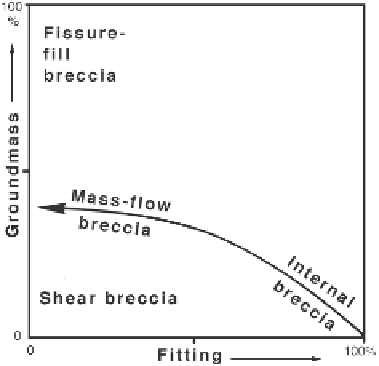Geology Reference
In-Depth Information
consider both roundness and shape (Sect. 4.3.1, Pl. 26/
3), or as the percentage of clasts with at least one
rounded edge (roundness number: Richter and Fücht-
bauer 1981). Breccias formed in place commonly con-
sist of high proportions of angular or only partly sub-
rounded clasts (e.g. internal breccias, karst breccias,
pedogenic breccias, Pl. 128/2, Pl. 129/1). Roundness
can increase with transport (e.g. in mass-flow breccias)
and by multiple reworking of breccia beds (Buggisch
and Flügel 1980). However note, that rounded carbon-
ate rock fragments are not necessarily products of abra-
sion during transport but can also be caused by partial
dissolution (Pl. 26/1) or replacement processes after
deposition. In addition, organic encrustations will
modify the shape of clasts and transform angular rock
fragments into round boulders.
Fitting
: Fitting (Richter and Füchtbauer 1981) de-
scribes the grain-to-grain relations of clasts - the de-
gree and percentage to which clast boundaries match
those of adjacent clasts (Pl. 26/1, 5). In measurements,
each clast is counted only once. Differences in fitting
are powerful criteria in distinguishing genetically dif-
ferent breccia types (Fig. 5.14).
Orientation
: The orientation of clasts may be ab-
sent or parallel to bedding or stress, and increasingly
or decreasingly parallel to the transport direction. Flat-
lying orientation in shallow-marine carbonate breccias
is sometimes caused by compaction. Current-controlled
deposition is manifested by the imbrication of clasts
and partial infilling of interstices between the clasts with
sand after the deposition of the gravel framework. How-
ever, it should be taken into account that 'pseudo-im-
brication' also occur at the foresets of large-scale cross-
stratification.
Fracturing or veining of clasts
occurs prior to brec-
ciation, during the process of brecciation, or subsequent
to brecciation (Pl. 26/3, 5, 7). Fractures and veins within
clasts of many mass-flow breccia and reef breccia pre-
date fracturing and veining whereas fracturing during
brecciation is common in caliche and solution breccia.
Internal breccias and shear breccias exhibit abundant
and superposed generations of post-brecciation frac-
tures and veins (Pl. 26/5). Internal breccias often show
inherited calcite-filled fractures. Microfractures should
be described by abundance, orientation, size and fill-
ing (see Sect. 5.3.2.2).
Clast/matrix boundary:
Most boundaries are sharp
(e.g. Pl. 26/3, 5) except for diagenetic pseudobreccias
and solution-evaporite-collapse breccias, which may
exhibit irregular replacement margins.
Microfacies
: Sampling for microfacies studies of
clasts must consider the size, roundness and shape,
packing of clasts as well as conspicuous sedimentary
Fig. 5.14.
Relations between fitting of clasts and the amount
of groundmass
(matrix + cement). After Füchtbauer and Rich-
ter (1983).
structures (e.g. stratification). Carbonate clasts of brec-
cias and conglomerates are classified according to depo-
sitional texture, composition and fossils. The frequency
and size of clasts give some indication of the proxim-
ity or distality of source areas. The relative proportions
of microfacies types should also be estimated or mea-
sured (e.g. counting all clasts within a defined thin-
section area). A comparison of standard microfacies
types (see Sect. 14.3) of breccia clasts with regional or
generalized facies models may provide clues to the
provenance area. Fossiliferous clasts must be tested with
an eye to age determinations.
Groundmass
Abundance of the matrix and clast/matrix ratio
:
Matrix can be abundant, scarce or even missing due to
diagenetic solution (e.g. stylobreccia). Differentiation
of breccia types and genetic interpretation requires the
quantitative data of the amount of matrix and the clast/
matrix ratio. These data are determined in the field
(sometimes also in large rock samples and thin sec-
tions) using the counting methods mentioned in con-
junction with the compositional clast analysis, or esti-
mating the frequency of clasts.
Matrix composition:
The matrix of carbonate brec-
cias consists of sediment or rock detritus formed by
the destruction and attrition of rock material.
The descriptive criteria of the sedimentary matrix
are color, mineralogy, uniformity, texture (e.g. micrite,
calcilutite or calcarenite matrix), and small-scaled sedi-
mentary structures (e.g. grading, lamination). Fine-
grained matrix is represented by (a) sediment depos-
ited between clasts coeval with the deposition of the

